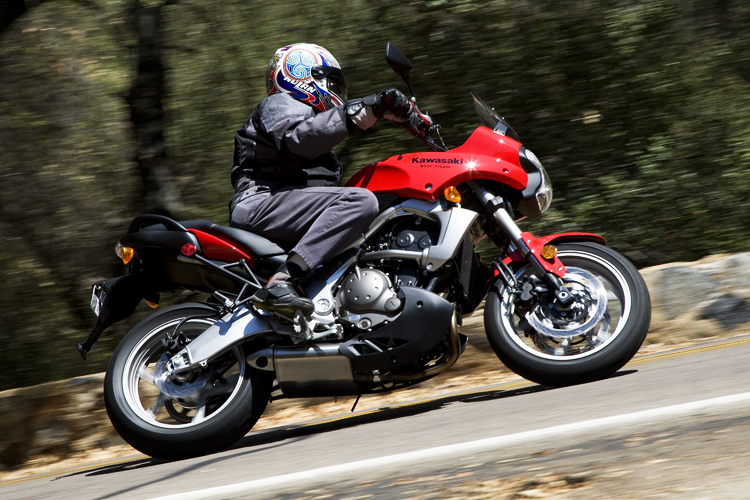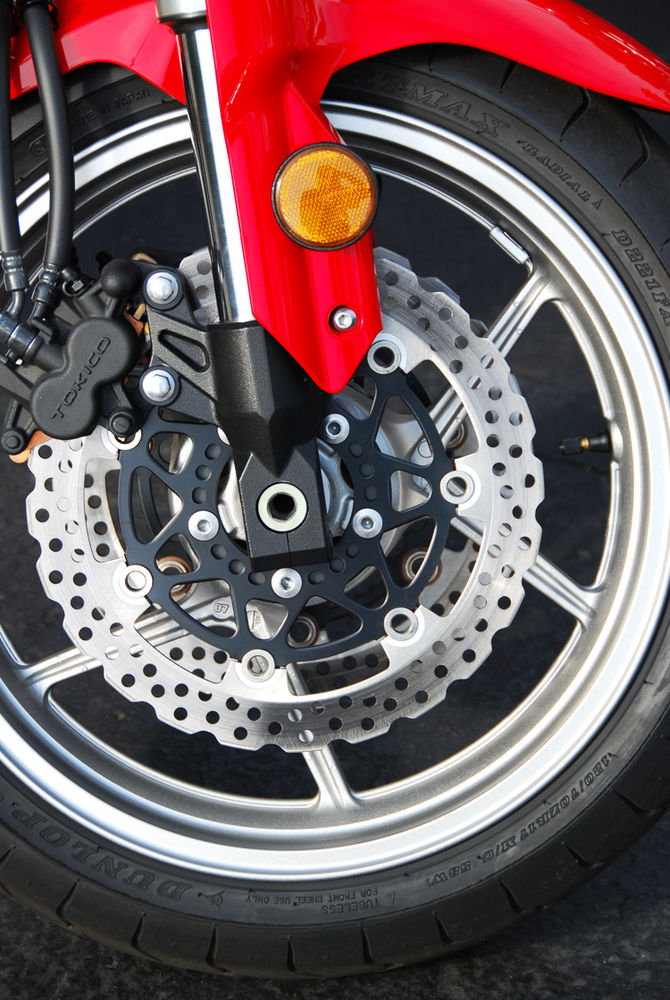Review: 2008 Kawasaki Versys 650

In dictionary terms, a system consists of a number of individual parts with particular attributes combined in appropriate relationships within a specific environment. The idea is that the whole will be greater than the sum of its parts - and once we got together to ride the roads in the hills above San Diego, I wondered if this definition would hold true for Kawasaki's cleverly named Versatility System motorcycle, the Versys?
I'm too busy taking pictures of the new Kawasaki Versys to notice that the other journalists in my pod are ready to roll. Heads up! I shove the camera back in its bag, throw on my helmet and gloves, hop on the bike, fire it up, and race out through the parking lot to catch up.
Wait a minute: let's back it up a second. I've just started and roared off on a bike I've never even sat on before without a thought for its temperament, controls or road manners. Obviously, none of that matters: Everything is precisely where it should be. All motorcycles should be like this!

That set the pattern for the day. The Versys did everything asked of it without fuss, and with an ease and lack of drama that made it feel like a favorite running shoe. And run it does, as a blast over the paved goat paths that line the baked hills above San Diego proved. This could be one of the best balanced, easiest to ride (and ride quickly) bikes in its class - and it's a class act to boot.
Beating the System
The Versys owes much of its lineage to Kawasaki's fast and friendly Ninja 650 sportbike. The Ninja package has been softened and remolded into a sit-up street standard that retains much of its parent's sporting prowess, yet this incarnation also gives it multi-use capability. As such, it joins a growing family of Swiss-army-knife bikes like the Ducati Multistrada, Triumph Tiger, Buell Ulysses, Suzuki's DL range, and others. Kawasaki intends for you to use the Versys in commuting, sport riding, light touring, and "urban assault," whatever that is. As one of the other journalists remarked, "The Versys could be the love child of a Ninja and a KLR650."
So what exactly has Kawasaki done to the Ninja to create the Versys? Both bikes share the same liquid-cooled, 649cc DOHC, eight-valve parallel twin motor, with the only differences being a softer compression ratio of 10.6:1 from the Ninja's 11.3, revised cam timing, and a header balance pipe. This gives the Versys slightly less output than the Ninja (44.9 ft. lbs. of torque vs. 48.5), but at 6,800rpm, or 200rpm lower. More significantly, the torque is spread over a wider range with the intention of making the Versys snappier off the line.
In the cycle department, a rear sub-frame has been added to the steel-tube-and-casting frame to provide extra strength for passenger and luggage carrying, while a new alloy swingarm accommodates a longer suspension travel of 5.7" (against the Ninja's 4.9"). Travel is actually longer at both ends with 5.9" at the front (4.9"), courtesy of a 41mm inverted Showa fork (41mm conventional Kayaba). Frame geometry is lazier too, with a 0.5-degree increase to 25 degrees, which results in 0.1" increase in trail to 4.3". Suspension is adjustable for preload and rebound damping at both ends.
The result of these changes is a bike that sits higher with a seat height of 33.1" (a lower seat is available), weighs six pounds more at 399 pounds, and has a 0.2" longer wheelbase at 55.7".

Ride on!
But more importantly - how does it ride? The engine starts easily, hot or cold, and settles to a fast idle. My Versys was showing zero miles, so the idle would probably need adjusting down at its first service. The hydraulic clutch action is light, and boasts an adjustable lever (as does the front brake) for those short, or long, of finger. First gear engages easily, and with a little throttle, the Versys moves smoothly away. The engine pulls willingly from just about any speed above idle, but definitely starts to haul harder above 3,000rpm, and it's between here and the 10,500rpm redline that it works best. The 180-degree twin shudders characteristically below 3,000rpm and there's some buzzing up to around 4,000rpm, but all is smooth above this.
Shifting is light and notch-free, and I didn't miss a shift all day. The Versys's sporty steering geometry and light weight make low-speed maneuvers easy and dauntless, so parking lot turns are a breeze. At higher speeds, the Versys feels light and flick-able, easy to turn in, with completely neutral handling; and in spite of the extra suspension travel over the Ninja, never once did the Versys try to stand up on me or change direction under braking in a turn. This is my favorite test of handling stability, especially on bikes likely to attract less experienced riders, and it provides a good indicator of suspension/steering balance.
On the subject of braking, the Versys features petal rotors (just like those on the hot-ticket sport bikes) gripped by Tokico calipers to ensure very effective stopping. Given the bike's intended use, brake balance is good, though the rear is perhaps a little too effective, and I hopped the back tire under hard braking a few times. Again, this slight rearward bias might be more reassuring for less experienced riders than the purely ornamental rear stoppers fitted to most sport bikes.

Suspension feels supple and handles minor road imperfections well, yet is firm enough for precise steering. Overall a good balance between comfort, compliance, and control. Front and rear suspension is adjustable for preload and rebound damping.
A blast through the hills above San Diego proved that the Versys is capable of moving very swiftly. Its overall performance envelope, while not in the same league as a 600-four, is surprisingly good. I was especially impressed by its ability to change direction on demand, and without instability, as we swung through a riotous series of tight twisties. The impression left is of a motorcycle that is never stressed by what the pilot throws at it, feeling secure and stable, and with a good safety margin.
As with the natural Ninja 650 comparisons to Suzuki's SV650S, it's impossible not to compare the Versys with the DL650. On paper, they're closely matched, but the DL feels physically larger (Kawasaki's parallel twin is much more compact than Suzuki's L-twin) and comes with more of a rough-terrain bias built into the suspension. It's also slower to turn and less nimble, perhaps because of a higher center of gravity. In this comparison, the Versys perhaps sits somewhere between the DL and Suzuki's plain-Jane SV650, incorporating the best features of both. And though the DL's lively, free-revving engine is one of my favorites, the Kawi parallel twin comes close to matching it. On smooth, tight, twists of pavement, the Versys ought to outdistance the "wee-strom" rather handily.
A couple of niggles: The Versys is a bit skimpy in the instrument department with just two tripmeters, an odometer and a clock. Though I'm sure this helps keep the price down, most mid-range bikes now feature a trip computer, especially those aimed at "light touring." The handy under-seat helmet hook works fine for D-ring helmet straps, but it doesn't work for my quick-release Nolan. On the plus side, Kawasaki lists hard luggage that they say will take a full-face helmet. Also available are two alternative windshields and a gel seat that lowers seat height by two inches.

So, when the dust settles, does the Versys actually have the bike-of-all-trades versatility Kawasaki implies that it has? It certainly meets the requirements of commuting and sport riding. But touring? One of the other reporters at the launch suggested it was impossible to determine whether the Versys was a good touring bike in half a day, and I'd agree - except that I'd be able to tell if it was not good for touring. I wouldn't have thought twice about riding "my" Versys the 1,500-odd miles home to Vancouver if Kawasaki had let me; and adding hard luggage and a GPS would deal with my other concerns. So a tourer it could well be. Hopefully Kawasaki will allow RoadRUNNER to put one to a long-term test.
As for "urban assault," you'll have to try that for yourself!
Parallel Twins
The parallel-twin engine format largely fell out of favor with the collapse of the British motorcycle industry; but it has a lot to offer for mid-size motorcycles. Typically more compact, lighter and less complex than a V-twin, the parallel twin's traditional shortcoming (vibration) is easily negated with modern engineering.
Kawasaki chose a 180-degree firing interval for their new 650 twins. Of the three main options for crankshaft firing intervals in a parallel twin - 180 degree, 270 degree and 360 degree - all offer advantages and disadvantages. In a 180-degree twin, the two pistons rise and fall alternately, each piston balancing out the mass of the other. But the design has two disadvantages: both pistons stop at the same time (one at the top of its stroke, the other at the bottom) leading to the buzzing characteristic of all in-line engines with "flat" crankshafts; and the firing intervals of 180 and 540 degrees give rise to a "pulsing" power delivery in the lower and mid rev ranges.

In a 360-degree twin, both pistons rise and fall together, and the mass needs to be countered with balance weights; but power delivery is smoother at low revs because of the even 360/360 firing interval. However, primary vibration can be fierce and balance shafts are a must, as well as flywheel counterweights. That means a 360 twin typically has a much heavier crankshaft, adding weight to the bike, and making the engine slower to spin up.
In a 270-degree twin, when one piston is at the top of its stroke, the other is half way between the top and bottom. The advantage of this layout is engine smoothness: when one piston is at rest, the other is close to its maximum speed, canceling primary vibration and its associated "buzzing." The disadvantage - as with the 180-degree twin - is uneven power delivery, with firing intervals of 270 and 450 degrees. Crankshaft manufacturing also requires an additional step: after forging, the crank must be re-heated and "twisted" to get the 270-degree angle for the big-end journals.
Most modern parallel twin engines use either a 270-degree (Triumph Scrambler and America) or 360-degree (Triumph Bonneville, Thruxton, and Kawasaki's own W650) crank, but Kawasaki has been shrewd in sticking with the 180 - as they used in their earlier 500 Ninja twin. They avoid the extra crankshaft-manufacturing step required for a 270 twin, and can keep the crankshaft weight down, relying on a balance shaft to take care of vibration. Very clever!
Technical Specs
+ Smooth power, nimble handling, good brakes
- Bike-for-all-reasons or identity crisis?
Distributor Kawasaki Motors Corp. USA
MSRP $ 6,899
Engine four-stroke parallel-twin, DOHC, 8-valve, 10.6:1 compression
Displacement 649cc
Bore x Stroke 83mm x 60mm
Fuel System fuel injection, 2x38mm throttle bodies
Power 44.9lb/ft
Cooling liquid
Ignition digital CDI
Transmission six speed
Frame semi-double cradle, high tensile steel
Front Suspension inverted 41mm Showa fork adjustable for springpreload and rebound
Rear Suspension single laydown shock adjustable for preload and rebound damping
Rake/Trail 25º/4.3in (109mm)
Brakes Front/Rear dual 300mm petal discs w/2-piston calipers, 220mm petal disc w/single-piston caliper
Tires Front/Rear 120/70ZR17, 160/60ZR17
Dry Weight 399lbs (181kg)
Wheelbase 55.7in (1415mm)
Seat Height 33.1in (841mm)
Fuel Capacity 5gal (19l)
Fuel Consumption n/a
Colors passion red








